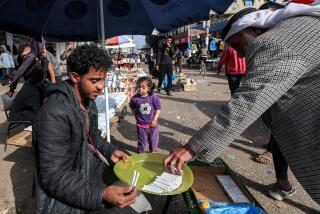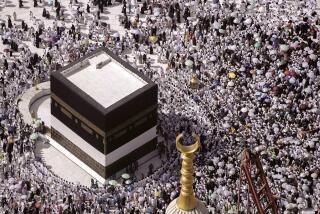More Livable Place : Cairo--A Face Lift for a Harridan
- Share via
CAIRO — On days when there is no desert wind, the air pollution here can be worse than Mexico City’s. The cacophony of automobile horns, screeching brakes, roaring truck and bus engines and crowds of people on the streets make it probably the noisiest city on Earth. Much of metropolitan Cairo is overcrowded, and many of its 14 to 15 million people live in wretched hovels.
Yet despite horrendous problems, the city that only a few years ago looked as if it might bury itself in its own effluence has taken giant strides toward being a more livable place.
To a former resident returning to Cairo after an absence of more than five years, the changes are startling.
Streets that were choked with rubbish are now mostly clear. Traffic that regularly achieved gridlock now moves steadily, albeit slowly, through most of the city. Telephones that were as useless as tin cans tied to a string now respond on command. Green parks abound. Public buildings sparkle with clean exteriors and fresh paint.
Spending Money at Last
Another visitor, an Egyptian diplomat back in his hometown after more than four years away, was also astonished. When asked how he thought the city had at last begun to erase the blight that has crept over it during the past 30 years, he reflected for a few moments and said:
“I’ll tell you what it is. At last, they are spending some money on the improvements they raised money for years ago.”
Actually, the money for Cairo’s face lift has come mostly from long-term U.S., Japanese and European aid commitments made as long as a decade ago. The improvements have been in the works, at least in the planning stage, since the days of the late President Anwar Sadat.
But the assassinated Sadat’s successor, Hosni Mubarak, justly takes credit for achieving what many people believed, just a few years ago, would never come to pass. Although beset by staggering nationwide social and economic problems, Mubarak’s 5 1/2-year-old government, along with the city administration, made a top priority of basic improvements in communications, transportation and water and waste disposal systems.
Signs Everywhere
The results are visible almost everywhere, from teeming passageways like Khayyam (Tentmaker) Street in old Cairo to the City of the Dead cemetery, where as many as 250,000 mostly middle-class people rent living space in villa-like tombs; from the lush tailored lawns of the once-decrepit Citadel, where Sadat imprisoned his opponents, to the city’s main square, where a new French-financed subway is nearing completion.
Like many of Cairo’s older sections, and some of its newer sections as well, the area around Khayyam Street suffered chronic sewage overflow problems, beginning 10 to 15 years ago when the ancient, British-designed system became fatally overtaxed by population growth. Shops where tentmakers have for centuries stitched colorful arabesque patterns for pillows, blankets and festive tents were often awash in infectious sewage.
A long-term sewer project, which will ultimately cost about $2 billion and is being financed by the U.S. and European governments, has already begun to show results. Khayyam Street and many others are now dry and clean, though parts of the city not yet reached by the new system still suffer overflows.
There is similar improvement in Khan el Khalili, familiar to generations of tourists as Cairo’s colorful but increasingly seedy bazaar. At the time of Sadat’s assassination, in October of 1981, the exotic aroma of spices that once hung over the bazaar had been all but overwhelmed by the stench of rubbish--and worse.
Today, the exotic aromas are back, and Khan el Khalili is probably cleaner than the average American shopping mall. Shopkeepers wield brooms to keep it that way, and small plastic trash cans at every corner serve as reminders to visitors not to litter.
This may seem a small thing to Westerners, but anti-litter discipline was until recently unheard of in Egypt. Traditionally, housewives have hurled their rubbish out of upper-story windows while uttering a ritual curse against the Turks who once governed the country.
Just outside Khan el Khalili, opposite the venerable Hussein mosque, a lush, green park with a fountain and tropical plants has replaced a sandlot where donkeys used to be tethered and cruelly exploited child beggars drew swarms of flies. It is one of many new parks in the city.
Beggars Disappearing
Even the beggars appear to have changed. Cairo’s begging industry, run for generations by a Mafia-like organization that battened on the wretched and dealt out concessions, is said to have been dealt a crippling blow under a long-running police crackdown. Few beggars are visible on streets where many used to plead for piasters.
Driving around the city, even at morning and evening rush hours, is easier than it was a few years ago. It is still no pleasure, but the addition of “flyway” overpasses or tunnels at the most congested intersections, and a subtle but discernible improvement in the road manners of many Cairo drivers have made it possible to move through the center of town faster by car than on foot or by donkey cart for the first time in a decade.
A longtime Cairo resident speculated that improved telephone service in greater Cairo has had a lot to do with easing traffic on the congested streets.
“Before the telephones started working, the streets were crowded with people going to visit people they couldn’t reach by telephone,” he said. “Now we can do a lot of our business by telephone and stay off the streets.”
Better public bus service has also made a difference in the traffic situation. A decade ago, Cairo’s antiquated buses had all but collapsed, leading what was then a new U.S. aid program to rush in a shipment of specially made American buses. But these, produced hastily by an American school-bus manufacturer, soon collapsed as well.
A common sight on the street was a bus with all its windows and doors broken out and exuding clouds of noxious exhaust fumes as dozens of distraught Cairenes attempted to board it on the run or to leap from it while still in motion. The cost was high, not only in traffic jams but in human lives.
Today, yet another generation of more durable buses is gradually being replaced by even better ones. All have the requisite number of intact windows and doors and one rarely sees passengers hanging from the outside or risking the running mount and dismount of old.
There are new mini-buses, too, on which passengers are guaranteed a seat and a comfortable ride to their destinations for a fare of about 15 cents.
The city’s monuments and public buildings have had a face lift and now contend bravely for attention with hundreds of high-rise office and apartment buildings that have sprung up along the Nile in the biggest building boom under way in the Arab world.
Most notable perhaps is the walled Citadel of Saladin, which dominates old Cairo from a towering limestone hill. Long used as an army and police barracks and a prison, the Citadel with its elaborate mosque has been restored to what it was in the early 19th Century. Surrounded by a rich lawn, it has become a museum and popular holiday escape from the city’s noise and congestion.
In the old Citadel prison, where Gamal Abdel Nasser and Anwar Sadat kept political prisoners, there is now a souvenir shop for tourists. Not far from the shop and the nearby police museum, waiters serve coffee and soft drinks in a garden that offers a spectacular view across the Nile to the Pyramids of Giza.
According to a native Cairene, whose family has lived at the foot of the Citadel hill since his great-great grandfather built a house there in the mid-1800s, the dressing up of the city is a welcome relief to a people who had begun to wonder if they were condemned to endless generations of deterioration.
“I feel pride that I didn’t feel before,” said Samir Gad, 54, a former Egyptian air force helicopter mechanic who is struggling to make a living selling refrigeration gases.
“Of course, we still have many problems--too many people and too little money. Life is hard. But it makes me feel good to see the progress here. I feel contentment here now.”
Schanche, who is now based in Rome, was correspondent in Cairo for The Times from 1976 to 1982.
More to Read
Sign up for Essential California
The most important California stories and recommendations in your inbox every morning.
You may occasionally receive promotional content from the Los Angeles Times.













